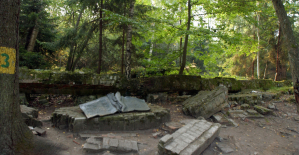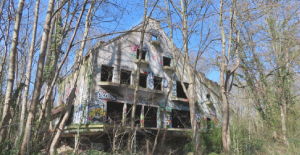It is over 2,700 years old, but with its braided beard and sides hidden behind a pair of delicately feathered wings, it is remarkably preserved. A lamassu, an Assyrian alabaster winged bull of “enormous” dimensions, was unveiled in Iraq by a mission led by a French archaeologist.
“The attention to plastic detail is incredible,” marvels Pascal Butterlin, professor of archeology of the ancient Near East at the University of Paris I Panthéon-Sorbonne, who led the mission made up of French, European and Iraqi archaeologists. . As proof: the feathers that make up the wings are practically like new, just like the hooves of this “hybrid, between animal and human” creature, explains the archaeologist to AFP who revealed the lamassu, buried underground, with his colleagues in mid-October. All that is missing is the head, “stolen in the 1990s by looters”, cut into 11 pieces, then found by Iraqi customs before ending up in the Iraqi National Museum in Baghdad.
The dimensions of this lamassu are impressive: it measures 3.8 by 3.9 meters, with an estimated weight of 18 tons, all made of gypsum alabaster. “I have never excavated something so big in my life,” says Pascal Butterlin. “Usually, it is only in Egypt or Cambodia that such enormous pieces are excavated!”
Produced at the time of the Assyrian king Sargon II whose reign extended from 722-705 BC, the lamassu was posted at the entrance to the city of Khorsabad, about 15 km north of present-day Mosul ( northern Iraq). In Mesopotamian mythology, he is one of “those monsters who were dominated and tamed. They are placed at the entrance to the city to protect it,” says Pascal Butterlin. “It is undoubtedly one of the last bulls to have been installed in Khorsabad before construction was interrupted” at the time of Sargon II.
Other examples of these protective geniuses are today presented at the Louvre, in the so-called Khorsabad courtyard, where the public has been able to discover them since the mid-19th century created by Paul Emile Botta.
Already mentioned by the French archaeologist Victor Place in the 19th century, the lamassu rediscovered this year was not documented again until the 1990s, when it was "cleared" for an "emergency intervention" by the Iraqi authorities. It was at this time that his head was cut off and stolen by looters. But the biography of the lamassu of Khorsabad also resonates with the contemporary history of Iraq. In 2014, when the Islamic State (IS) group swept through the north of the country, the village was deserted by its inhabitants. The latter knew of the existence of the lamassu and they “protected and hid” it before fleeing, says Pascal Butterlin.

 Who was Dror Or, the Israeli father who died as a hostage in the hands of Hamas?
Who was Dror Or, the Israeli father who died as a hostage in the hands of Hamas? “Pay in cash”: at his trial, Donald Trump faced with an embarrassing recording
“Pay in cash”: at his trial, Donald Trump faced with an embarrassing recording Italy: a grandmother accidentally serves a bottle filled with wine to a baby, he has an alcoholic coma
Italy: a grandmother accidentally serves a bottle filled with wine to a baby, he has an alcoholic coma The mysterious skeletons of Hermann Göring's villa
The mysterious skeletons of Hermann Göring's villa Children born thanks to PMA do not have more cancers than others
Children born thanks to PMA do not have more cancers than others Breast cancer: less than one in two French women follow screening recommendations
Breast cancer: less than one in two French women follow screening recommendations “Dazzling” symptoms, 5,000 deaths per year, non-existent vaccine... What is Lassa fever, a case of which has been identified in Île-de-France?
“Dazzling” symptoms, 5,000 deaths per year, non-existent vaccine... What is Lassa fever, a case of which has been identified in Île-de-France? Sánchez cancels his agenda and considers resigning: "I need to stop and reflect"
Sánchez cancels his agenda and considers resigning: "I need to stop and reflect" Health carpooling, this source of savings which arouses the ire of patients and taxis
Health carpooling, this source of savings which arouses the ire of patients and taxis Tesla Model 3, MG4 and Dacia Spring.... With the end of the ecological bonus, these electric cars produced in China are seeing their sales fall
Tesla Model 3, MG4 and Dacia Spring.... With the end of the ecological bonus, these electric cars produced in China are seeing their sales fall For the 2024 Olympics, Airbnb commits to fighting prostitution in its accommodation
For the 2024 Olympics, Airbnb commits to fighting prostitution in its accommodation “Shrinkflation”: supermarkets obliged to alert their customers from July 1
“Shrinkflation”: supermarkets obliged to alert their customers from July 1 The electro of Justice and the echoes of Portishead
The electro of Justice and the echoes of Portishead 1924 Olympic Games: according to his daughter, the hero of Chariots of Fire was “not a bigot”
1924 Olympic Games: according to his daughter, the hero of Chariots of Fire was “not a bigot” The “German Brothel” in Yvelines: an uncertain future for the ruined residence
The “German Brothel” in Yvelines: an uncertain future for the ruined residence The eye of the INA: when Paul Auster visited Bernard Pivot
The eye of the INA: when Paul Auster visited Bernard Pivot Omoda 7, another Chinese car that could be manufactured in Spain
Omoda 7, another Chinese car that could be manufactured in Spain BYD chooses CA Auto Bank as financial partner in Spain
BYD chooses CA Auto Bank as financial partner in Spain Tesla and Baidu sign key agreement to boost development of autonomous driving
Tesla and Baidu sign key agreement to boost development of autonomous driving Skoda Kodiaq 2024: a 'beast' plug-in hybrid SUV
Skoda Kodiaq 2024: a 'beast' plug-in hybrid SUV The home mortgage firm rises 3.8% in February and the average interest moderates to 3.33%
The home mortgage firm rises 3.8% in February and the average interest moderates to 3.33% This is how housing prices have changed in Spain in the last decade
This is how housing prices have changed in Spain in the last decade The home mortgage firm drops 10% in January and interest soars to 3.46%
The home mortgage firm drops 10% in January and interest soars to 3.46% The jewel of the Rocío de Nagüeles urbanization: a dream villa in Marbella
The jewel of the Rocío de Nagüeles urbanization: a dream villa in Marbella Facing Jordan Bardella, the popularity match turns to Gabriel Attal’s advantage
Facing Jordan Bardella, the popularity match turns to Gabriel Attal’s advantage Europeans: a senior official on the National Rally list
Europeans: a senior official on the National Rally list Blockade of Sciences Po: the right denounces a “drift”, the government charges the rebels
Blockade of Sciences Po: the right denounces a “drift”, the government charges the rebels Even on a mission for NATO, the Charles-de-Gaulle remains under French control, Lecornu responds to Mélenchon
Even on a mission for NATO, the Charles-de-Gaulle remains under French control, Lecornu responds to Mélenchon These French cities that will boycott the World Cup in Qatar
These French cities that will boycott the World Cup in Qatar Monaco - Clermont: Minamino cornerstone, Fofana essential, the Clermont defense overwhelmed... The tops and the flops
Monaco - Clermont: Minamino cornerstone, Fofana essential, the Clermont defense overwhelmed... The tops and the flops Gymnastics: two gold medals for the Italian Manila Esposito during the European Championships
Gymnastics: two gold medals for the Italian Manila Esposito during the European Championships Champions Cup: in pain, Leinster beats Northampton and qualifies for the final
Champions Cup: in pain, Leinster beats Northampton and qualifies for the final Liga: Real Madrid crowned champion of Spain after FC Barcelona's defeat in Girona
Liga: Real Madrid crowned champion of Spain after FC Barcelona's defeat in Girona


















